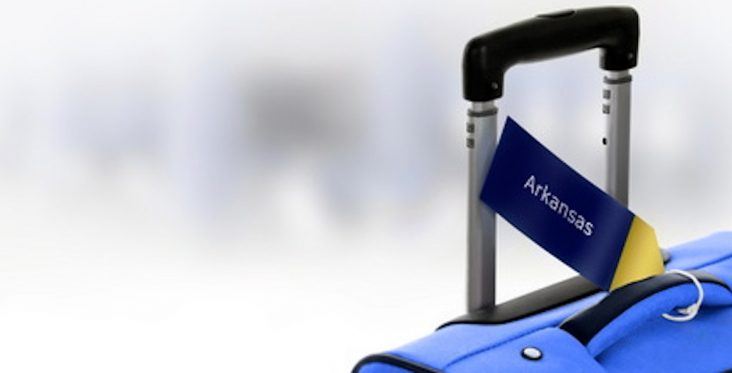Average air fares down in Arkansas, lowest in Little Rock
by July 26, 2017 4:52 pm 612 views

Arkansas. Blue suitcase with label at airport.
The busiest airport in Arkansas also had the cheapest average fare for domestic flights in the first quarter of 2017, according to data released Tuesday (July 25) from the U.S. Department of Transportation’s Bureau of Transportation Statistics.
The average roundtrip air fare leaving from Bill and Hillary Clinton National Airport (LIT) in Little Rock during the first quarter was $437, average air fare leaving the Texarkana Regional Airport (TXK) was $477, the price at Northwest Arkansas Regional Airport (XNA) in Highfill, near Bentonville, was $538, and at Fort Smith Regional Airport (FSM) the average cost was $574, according to the data.
First-quarter air fare costs for domestic flights were down year over year at those four airports and nationwide, while airlines increasingly depended on fees for revenue, according to BTS.
The average roundtrip airfare for the Arkansas airports was $506, down 6.4% year over year, when last year’s costs are adjusted for inflation. Prices were up 5% from the fourth quarter of 2016. Held against last year’s unadjusted numbers, prices were down 4% year over year, and up 6% from the previous quarter. After rising sharply in 2015, between then and the beginning of this year, the prices declined for six quarters in a row in Arkansas and nationwide, according to BTS data.
Marsha Fuller, a travel consultant at Destinations of Fayetteville and 33-year veteran of the industry, said in an email she hasn’t felt a decrease in air fares, although pricing varies.
“I tell my clients that the airfares are like playing with the stock market,” she wrote. “You never know what they are going to be from day to day.”
A BTS press release on the new data states that fares include only the price paid at the time of the ticket purchase and do not include charges for extras like baggage fees and other services that are deemed optional. Those fees seem to make up an increasing percentage of airlines’ revenue, according to BTS. In 1995, air fare was 88% of airline revenue, and in 2017 air fare is down to 74% of revenue, according to the bureau.
Little Rock, with 112,360 originating passengers reported during the first quarter, is the busiest airport in the state. XNA, with 87,990 reporter passengers, is the second, according to BTS.
Little Rock deals primarily in leisure travel, said Jim Dailey, chair of the Little Rock Municipal Airport Commission. Most direct flights at XNA are for corporate customers, not the leisure traveler, Fuller said in the email.
“I think the fluctuation in air fare cost is based on what the market in our area is doing,” she said. “For example: We have a huge corporate industry in our area with Wal-Mart, J.B. Hunt, Tyson, and all the vendors for these companies alone would fill our planes.”
When providing such a large chunk of an airlines’ business in a given region, those companies can persuade the airlines to drop prices, said Fuller, who worked three years as a travel consultant for Wal-Mart.
Still, XNA’s air fare costs are higher than the national average for roundtrip domestic flights at $352 in the first quarter of 2017. That average was down 5% from $370 in the first quarter of 2016, when adjusted for inflation, but up 1.5% from $347 in the fourth quarter of 2016.
The average first-quarter costs for major airports were lower in the states surrounding Arkansas, except Mississippi, where the average was $508. Average domestic air fare cost in Texas was $427, Missouri was $428, Tennessee was $438, Oklahoma was $439 and Louisiana was $495.
Fuller’s said Destinations of Fayetteville works with leisure travelers who are often on the hunt for a bargain, and that sometimes drives them out of state for flights.
“We have a lot of customers who are looking to save money on vacations anyway they can,” Fuller said. “We normally will check airfares from XNA, Fort Smith and Tulsa to give the customer a choice on if they want to drive to save money. Normally they can save $150 or more driving to Tulsa.”
